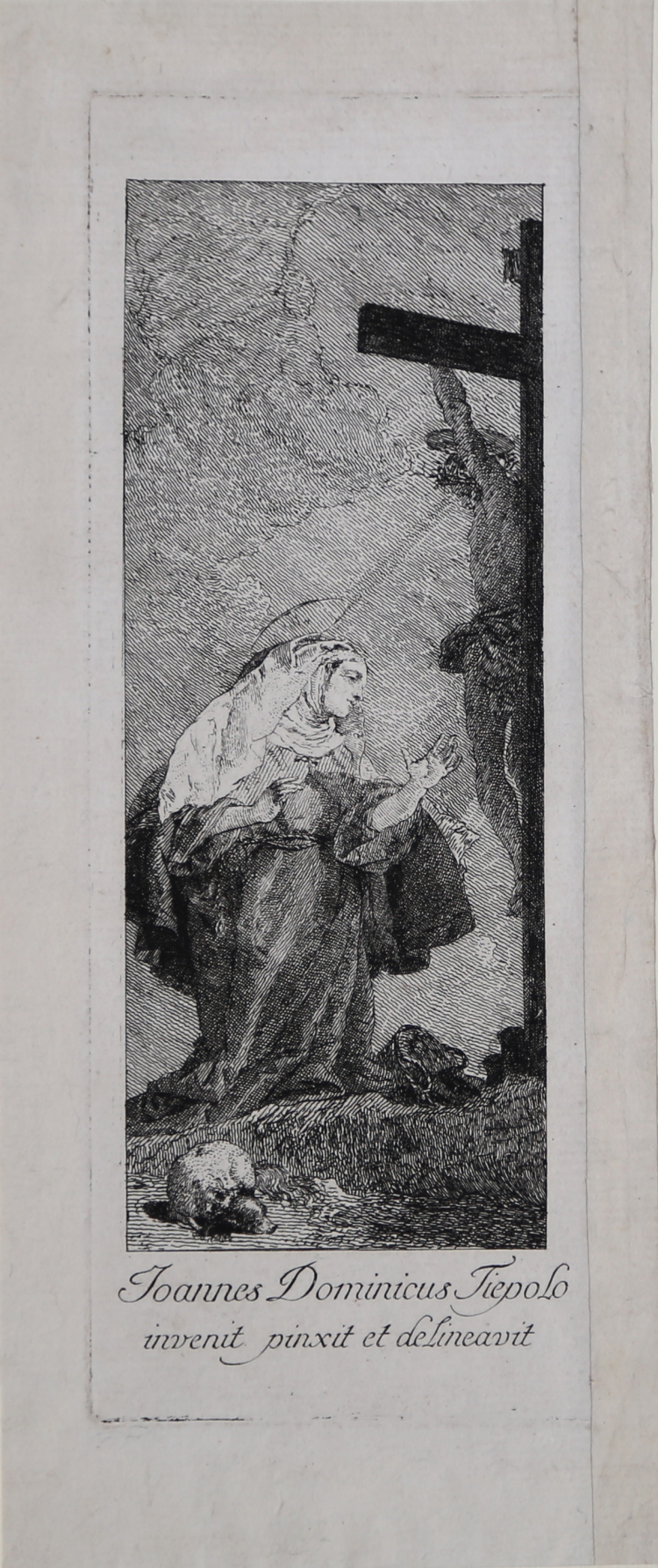



| Reference: | S38353 |
| Author | Giandomenico TIEPOLO |
| Year: | 1750 ca. |
| Measures: | 94 x 256 mm |


| Reference: | S38353 |
| Author | Giandomenico TIEPOLO |
| Year: | 1750 ca. |
| Measures: | 94 x 256 mm |
Ethcing and engraving, 1750 circa, inscriber lower margin “Joannes Dominicus Tiepolo/ invenit pinxit et delineavit”. Example of first state, of two, before number 7 added at upper right.
A magnificent example, printed with tone on contemporary laid paper, showing margins on three sides and trimmed to the platemark at the right edge.
After a lost painting executer by Giandomenico for the Church of S. Polo in 1749. The pictorial decoration of the Oratory of the Crucifix adjoining the church of San Polo carried out between 1747 and 1749 is the first work by Giandomenico Tiepolo. A late eighteenth-century inventory held in the patriarchal archive in Venice - which lists the paintings then in the oratory in their original order - shows that Giandomenico consigned twenty-four canvases to the parish priest, Bartolomeo Carminati, who directed the rebuilding of the room financed mainly by the charity of the faithful.
In pre-editorial issue, the plate, in the first state, was printed on a single sheet together with the "St. Joseph Calasanz”, so our example, on the right edge, is trimmed to platemark.
In the first three editions of the "Catalog" the plate is listed in series 7, n. 1, with the title "S. Margarita da Cortona "; in the fourth edition, instead, under the n. 4.
The original plate is at the Correr Museum (Tonini, "I Tiepolo ...", No. 13).
The print was sent to Mariette together with the " St. Joseph Calasanz " with the invoice dated December 29, 1575 and the indication "due santi per bislungo".
|
Succi, p. 523 n. 26; Knox 088, i/ii Rizzi 63, i/ii; de Vesme 68, i/ii.
|
Giandomenico TIEPOLO (Venezia 1727 - 1804)
|
Giambattista’s eldest surviving son, he entered his father’s studio in the early 1740s, where he learnt his art by copying his father’s drawings and etchings. In 1747, aged 20, Giandomenico painted a cycle of 14 paintings, the Via Crucis (Stations of the Cross) for the oratory of the Crucifix in S Polo, Venice (in situ). He avoided any hint of Giambattista’s grandiloquence and created tender scenes that portray the suffering of Christ, the grief of his followers and the cold objectivity of the bystanders in a straightforward manner. From 1750 to 1770 Giandomenico was both his father’s assistant and associate as well as an independent artist, although at times the roles merged. From 1750 to 1753 they were preparing and executing the fresco decorations in the Würzburg Residenz, but Giandomenico was also producing a large number of his own works, such as the Institution of the Eucharist (1753; Copenhagen, Stat. Mus. Kst). This is painted in the simple and direct manner that is typical of his art both as regards subject-matter—for example the Minuet (c. 1755; Barcelona, Mus. A. Catalunya), where the pleasure of a country dance is conveyed—and composition—for example the Four Camaldolese Saints (c. 1756; Verona, Castelvecchio), in which the figures are very simply grouped together.
|
|
Succi, p. 523 n. 26; Knox 088, i/ii Rizzi 63, i/ii; de Vesme 68, i/ii.
|
Giandomenico TIEPOLO (Venezia 1727 - 1804)
|
Giambattista’s eldest surviving son, he entered his father’s studio in the early 1740s, where he learnt his art by copying his father’s drawings and etchings. In 1747, aged 20, Giandomenico painted a cycle of 14 paintings, the Via Crucis (Stations of the Cross) for the oratory of the Crucifix in S Polo, Venice (in situ). He avoided any hint of Giambattista’s grandiloquence and created tender scenes that portray the suffering of Christ, the grief of his followers and the cold objectivity of the bystanders in a straightforward manner. From 1750 to 1770 Giandomenico was both his father’s assistant and associate as well as an independent artist, although at times the roles merged. From 1750 to 1753 they were preparing and executing the fresco decorations in the Würzburg Residenz, but Giandomenico was also producing a large number of his own works, such as the Institution of the Eucharist (1753; Copenhagen, Stat. Mus. Kst). This is painted in the simple and direct manner that is typical of his art both as regards subject-matter—for example the Minuet (c. 1755; Barcelona, Mus. A. Catalunya), where the pleasure of a country dance is conveyed—and composition—for example the Four Camaldolese Saints (c. 1756; Verona, Castelvecchio), in which the figures are very simply grouped together.
|